In 2021, second-shift digital entrepreneurship isn’t exactly a new phenomenon—but it is more popular than ever. According to Google Trends, online interest in “side hustle” has grown steadily since 2016—and reached an all-time high as 2020 drew to a close.
What is new is consumers’ increased appetite for online shopping, and that means big opportunities for ecommerce businesses. But spend five minutes wading through the sea of product offerings on Amazon.com and you’ll realize that getting ahead as an ecommerce seller takes a bit of effort.
To be successful in the long term, you need to find product niches with enough room for newcomers to thrive. Typically, that means selling products with sufficient demand, but relatively little competition that would otherwise drown out your chance to profit—or creating a brand-new product that consumers didn’t even know they needed.
So how, exactly, do you find these unicorn niches? By keeping up with consumer trends, tracking the competition, and doing some good old product research. Fortunately, Jungle Scout’s tools, industry research reports, and in-depth seller guides convey all of this information, so you can discover your winning business idea with ease.
To help you get started, let’s go over some of this year’s top ecommerce business ideas. We’ll highlight popular product categories and offer specific examples of profitable products based on what people are buying and selling in 2021. Then, we’ll discuss the product research methods we used to find them, and how consumer and seller behaviors might change in the future.
The top 20 ecommerce business ideas for 2021
Here are our top business ideas for ecommerce entrepreneurs. We’ve analyzed them by product category, ranked according to what consumers plan to buy online in 2021. Screenshots of Jungle Scout’s Chrome Extension and Opportunity Finder tools in action reveal each product niche’s recent performance on Amazon.
1. TikTok clothes
Not all young people have the disposable income to buy clothes—but that hasn’t stopped TikTok, a video sharing app most popular among users aged 10-29, from dominating fashion in 2020. Like Instagram before it, TikTok is driving online clothing sales via viral posts about styling lookbooks and clothing “hauls,” posted by everyone from hobby fashionistas to influencers to high-fashion brands. With its launch of TikTok Shops, the social media platform invites brands and affiliates to market their wares directly to the billions of users who follow hashtags like #fashion on TikTok.
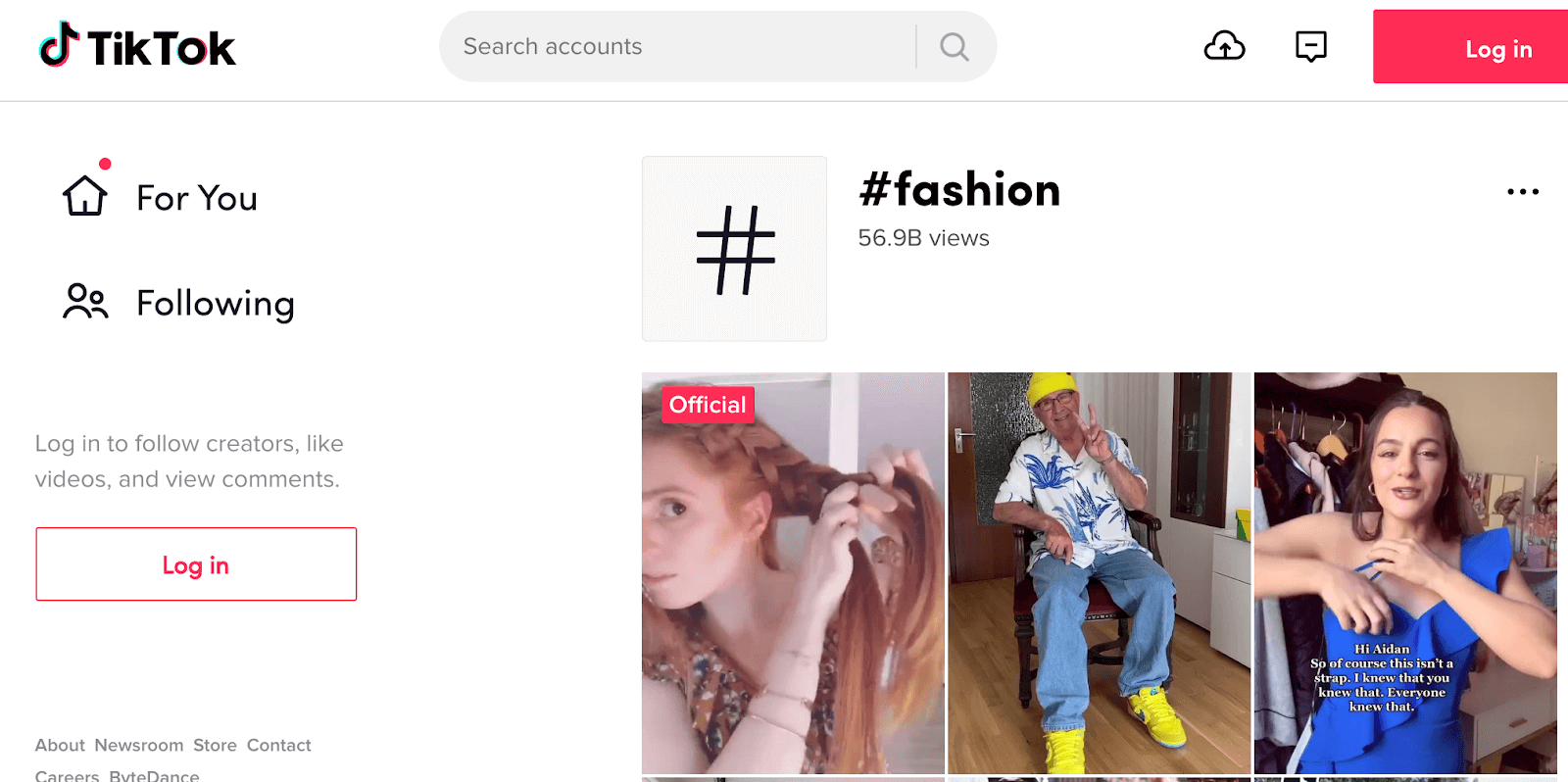
Keep an eye on the kinds of clothes that are trending on TikTok, and try listing those that rank well on Amazon. Who knows—your listing could be seen by hundreds of thousands of social media users.
2. Vaccine-related gear
If you’ve read our article on the wild success of shirts, hats, masks, and pins emblazoned with the phrase “Hug me, I’m vaccinated,” then you’re aware that people want to convey their health status through fashion. There’s still plenty of time to jump in on this trend—or to create some other COVID-related gear. 
Selling clothing
Pros: Clothing is the top category for online shopping in 2021—49% of U.S. consumers plan to buy their clothing on Amazon or from other online retailers this year. People may be leaving home less frequently, but they still want to feel good in what they’re wearing. This has opened the door to a massive loungewear trend, with relaxed cuts and inclusive sizes that are easy to execute for new ecommerce sellers.
Cons: It’s the top consumer category, meaning lots of other sellers will jump on board to take advantage of its popularity—and that’s not even addressing existing clothing sellers. You can succeed in selling clothes on Amazon, but it’s imperative that you find a unique angle.
3. Books on nutrition and diet
Consumers’ interest in their physical health and well-being has jumped in the past several months. This means they’re looking for advice on what to eat, as evidenced by the sales performance of nutrition books on Amazon.

4. Books on self care
The same goes for their mental health—nearly half of all consumers have made it a focus area in 2021. Selling high-converting titles on wellness and spiritual solutions to self care is a profitable move.

Selling books
Pros: At Jungle Scout, we’re big fans of selling used books on Amazon. It’s one of the easiest ways to get started with ecommerce, because you can find best-sellers hiding on your shelves at home. Fiction books tend to sell for super cheap if they’re used, so nonfiction titles will be your best bet. Given consumers’ interest in health and wellness and spirituality in 2021, it should be no issue to sell used books covering nutrition, cooking, and religion.
Accumulating inventory of used books also isn’t as difficult as it might sound at first. Once you’ve exhausted your home library, try browsing secondhand sites like eBay, Craigslist, and Facebook Marketplace, where you can find entire lots of used books for low prices.
Cons: You’ll have to do some research to make sure you’re listing books that actually sell well online. You can do that by checking a given title’s Best Sellers Rank on Amazon—the higher the rank, the more sales the listing earns.
5. Stylish cat trees
I think I speak for many people when I say that standard-issue, carpeted cat tree/jungle gym/climbing towers are unforgivably ugly. There’s a market for sleeker versions for design-conscious pet parents, but the offerings tend to be expensive.
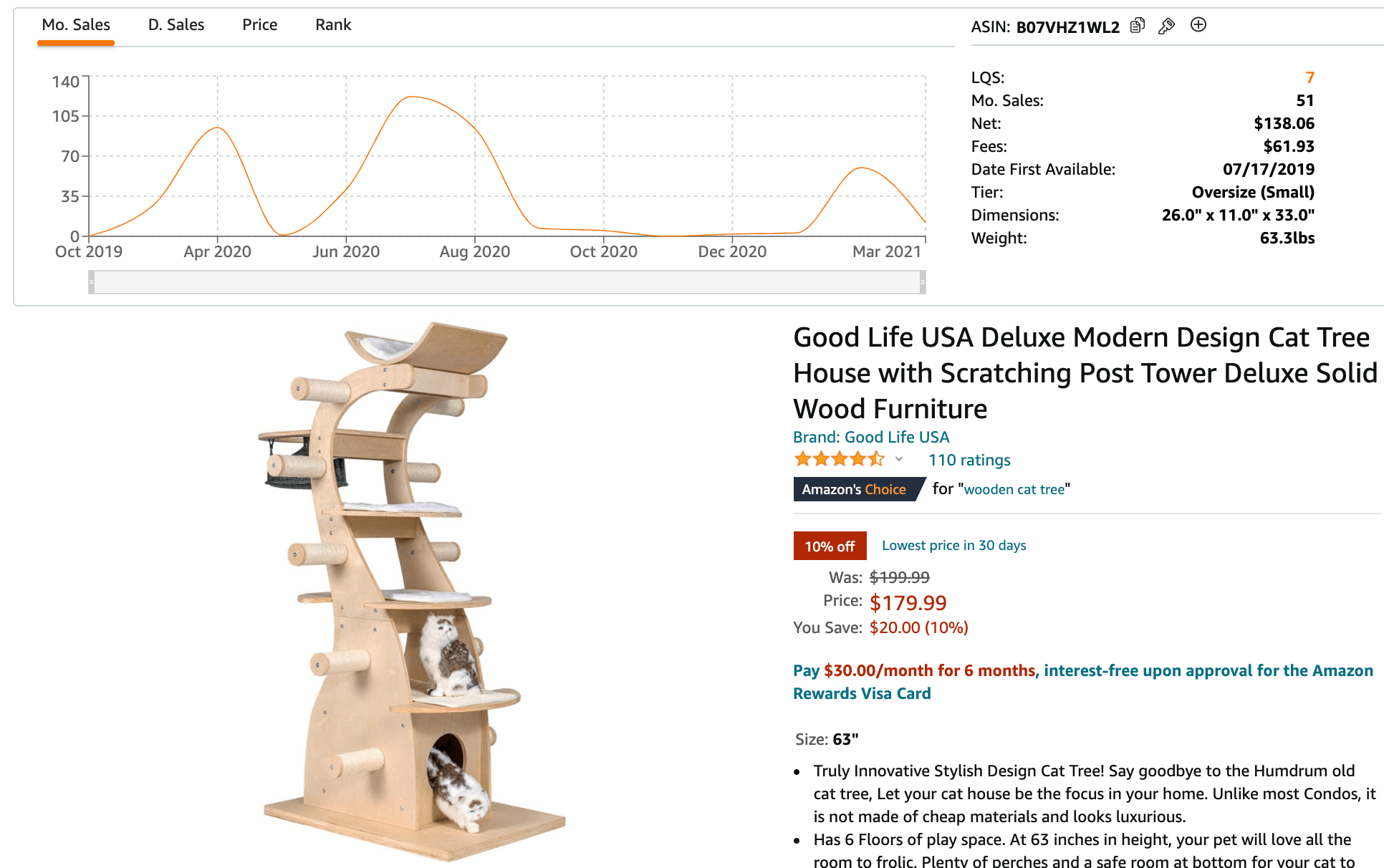
6. Natural pet toys and treats
There’s a new trend toward “natural” pet toys and treats that use “clean” or unusual ingredients, unbleached cotton and BPA-free plastics. Here’s an example: these yak milk chew toys. Despite being visually unappealing to everyone except the dog, they’re selling like hotcakes.
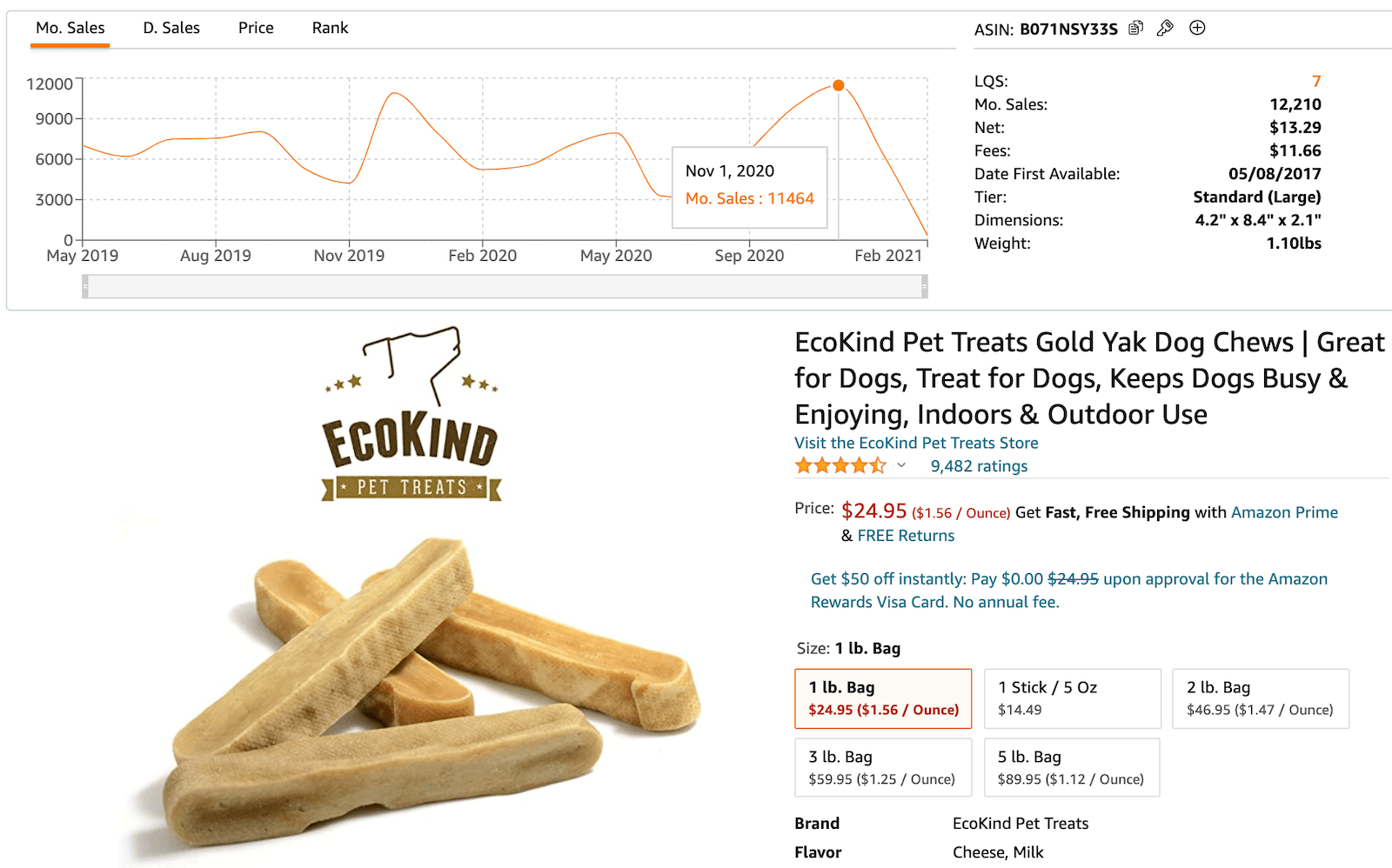
Selling pet supplies
Pros: Not only are pet products lucrative, they’re fun to product-test (if you like petting cute, fuzzy animals, that is). One third of U.S. consumers consider their pets a priority in their lives, and 50% of these pet lovers plan to buy supplies like food, toys, and beds on the internet.
Cons: Lots of other people also want to sell pet products. The good news is that the sheer variety of pets and their individual entertainment and maintenance needs translates to many sub-niches.
7. Acrylic nail art
Former nail salon regulars are taking on complicated nail art at home. This includes acrylic, or “fake” nail treatments. Try listing kits that include UV lights and fans, or sell your own holiday-specific nail stickers for a seasonal sales boost.

8. Home hair dye
People are also skipping their hair appointments in favor of DIY dye jobs. Reselling popular brands of home hair dye, like L’Oreal or Garnier, is a great opportunity for retail arbitrage.

Selling beauty & personal care items
Beauty and personal care products run the gamut from facial moisturizer to hair scrunchies to nail files. This is a broad category with lots of room for newcomers and plenty of demand: 43% of U.S. consumers will shop online for beauty products in 2021.
Pros: As with fashion, beauty and personal care brands benefit from social media’s viral marketing power. Thanks to Instagram, TikTok, and Zoom meetings, there will never be a time when people don’t care about looking good—and now, many beauty routines that historically take place in salons and spas are happening at home. Combine that with consumers’ increased focus on health in 2021, and you’ve got a winning proposition for an ecommerce business.
Cons: Because of the breadth of this category, there are seemingly endless product options to choose from. To avoid analysis paralysis stalling your product research before it even starts, pick a body part—hair, skin, or nails—and go from there.
9. Bath mats
In 2021, shoppers want to spice up their everyday home routines with appealing decor. Take for example this cute, peach-themed mat, which has sold 837 times in the past 30 days.
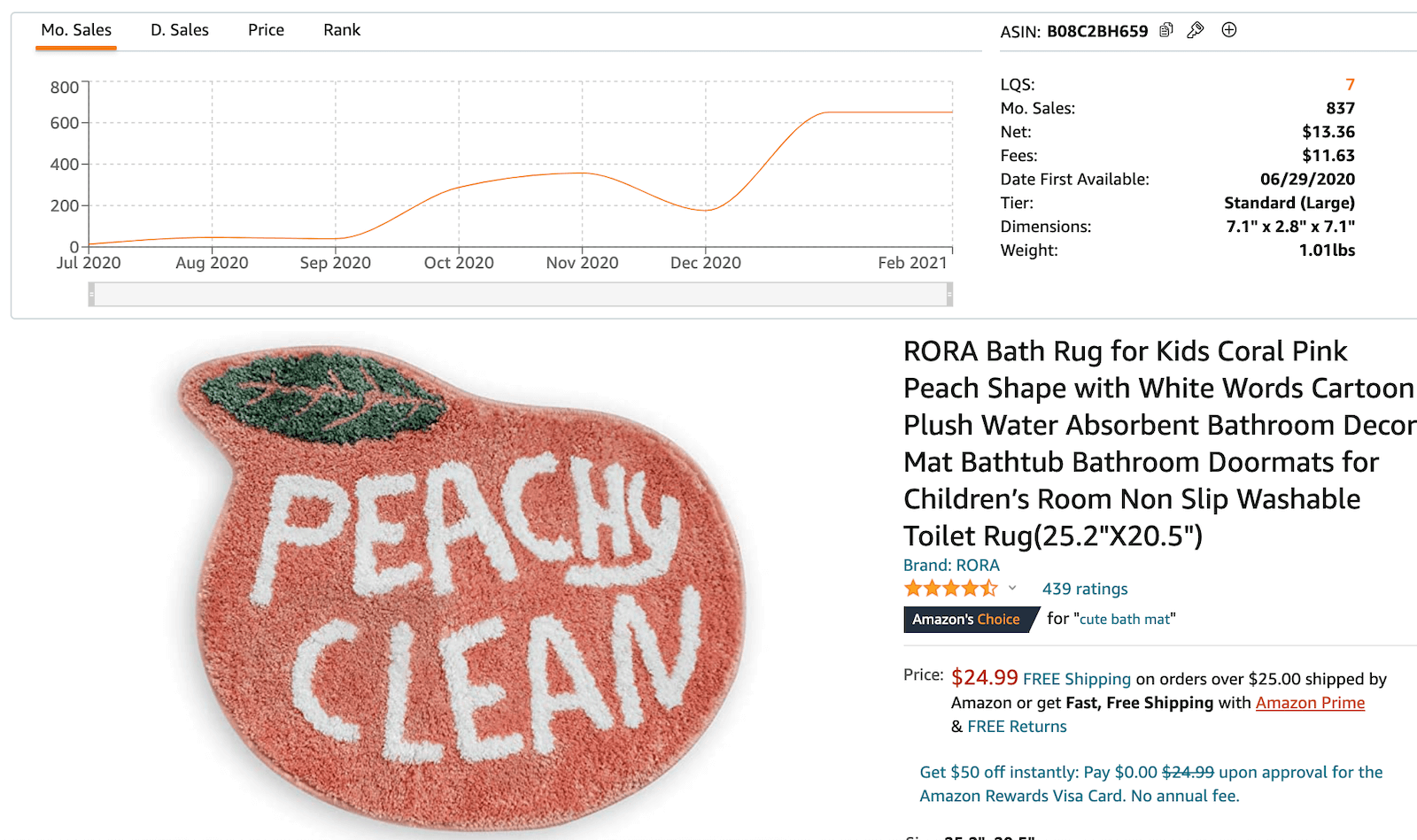
10. Woodsy decor
If you pay attention to home decor trends, you may have noticed a surging interest in the “cottagecore” aesthetic. Similar to “shabby-chic” or “rustic” trends of the past, cottagecore evokes idyllic rural life and cozy, vintage comfort. A popular motif within the trend is foraging in the woods, which is reflected in the demand for mushroom-themed home decor.

Selling home & kitchen products
A curious thing happens when you’re homebound: you begin to notice all the ways your living space isn’t quite as welcoming as you’d like it to be. The solution? Online shopping for furniture, appliances, and decor.
Pros: If you’re passionate about interior decorating, this is your time to shine. 43% of consumers will shop online in 2021 for home and kitchen products, which include everything from coffee makers to couches. Ecommerce sellers can easily jump into this category by listing textiles like sheets and shower curtains.
Cons: This category includes some heavy or otherwise unwieldy products that can be difficult for small businesses to source and ship—think large furniture or delicate, handmade glassware. Assess packaging costs with your supplier before going all-in on an oversized or fragile product.
11. Dietary restriction-sensitive protein powder
Vegans, the religiously inclined, and people with IBS want sick gains, too. Maybe that’s why plant-based, halal, and low-FODMAP protein powder listings are doing so well on Amazon.
12. Sleep aids
Everyone knows sleep does wonders for physical and mental health. A lesser-known fact is that sleep-related products sell incredibly well online.

Melatonin gummies may be old hat at this point, but these chocolate and chamomile melatonin candies are picking up steam.
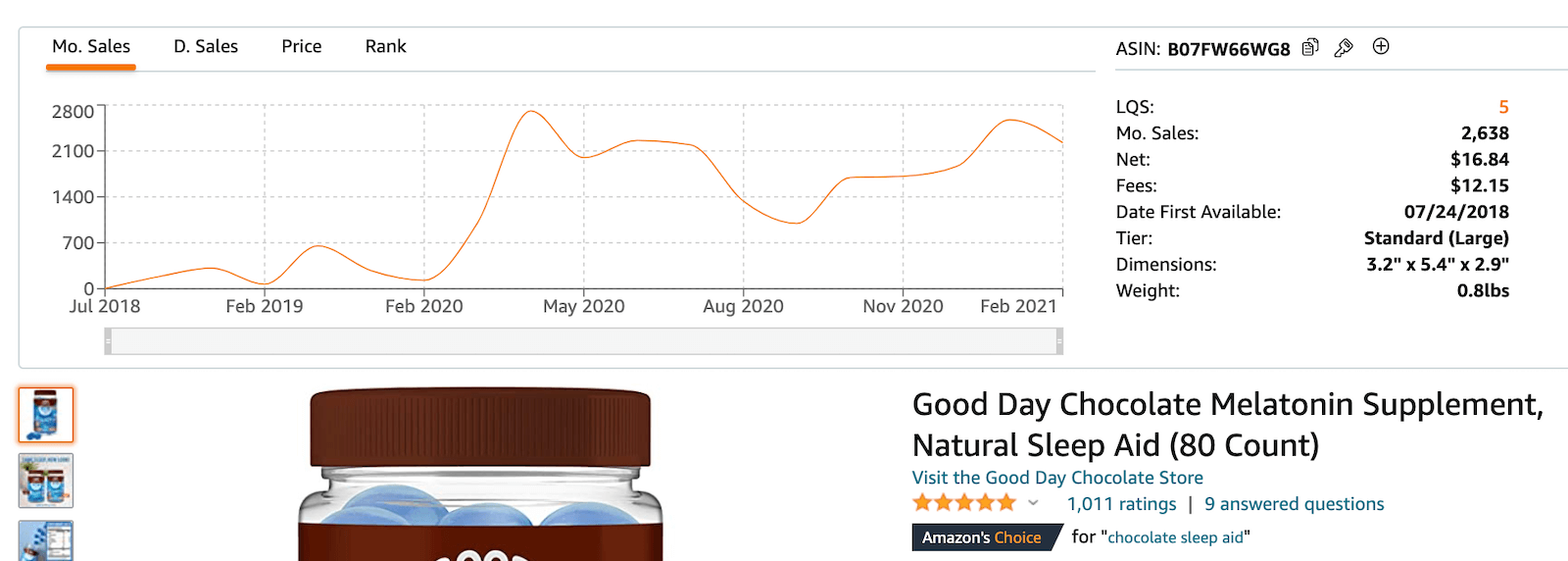
Selling vitamins & dietary supplements
Pros: 2021 is all about the personal wellness journey, which for many people involves a check-in on how “balanced” their breakfast really is. Selling vitamins can be a profitable business move, especially since 43% of consumers will purchase them online in 2021. Thanks to the tenacious popularity of “superfoods,” sellers can list fun-sounding ingredients like moringa, “functional mushroom powder,” and blue algae in addition to steady favorites like fish oil capsules and whey protein isolate.
Cons: The supplement industry is notoriously scam-ridden: see the public outcry surrounding “flat tummy tea.” Customers will notice if your product doesn’t live up to its claims, and will take out their frustrations on your product reviews. Don’t make grandiose promises on your product packaging if there’s no chance that they’ll come true.
13. Funko Pop collectibles
The resale market for pop-culturally relevant bobbleheads is booming. If you can get your hands on a limited-edition Funko figurine, you’re in business.

14. Movie character toys
With the right cuteness quotient, an animated character’s toy likenesses will continue to sell well after its silver-screen premiere. Just take Baby Yoda, the minions from Despicable Me, and Elsa from Frozen. Keep an eye out for kids movies slated for 2021—between the Tom & Jerry reboot, Cruella, and a handful other talking-animal features, you’re bound to find toy merch that’ll sell well through retail arbitrage.

Selling toys & games
Pros: Kids and adults alike need entertainment, making this an age-inclusive category in which 43% of consumers plan to shop online in 2021. When thinking about toys to sell, it can also be helpful to consider kids’ needs at different stages of growth, as this helps further specify a niche. A ten-year-old won’t want to play with toddler toys, so there’s lots of room for variety.
Cons: Popular characters tend to sell well, but are obviously protected by licensing laws. So you won’t be able to list your own version of a best-selling Pixar character action figure. However, there are plenty of examples of high-performing toy listings from brands that aren’t household names.
15. Office chair seat cushions
It’s a sad truth: the coolest-looking office chairs are often the least comfortable. Your new line of ergonomic memory foam office chair cushions are just what stylish remote workers need.

16. Fidget devices
The fidget spinner may be old news, but demand for handheld stress-relief doo-dads is still strong. This is true for adults as well as kids; fidget toys can be marketed as toys and office supplies, and perform well in both categories on Amazon.

Try selling fidget toy product bundles like the one pictured below—the variety of colors and shapes make your listing more appealing.
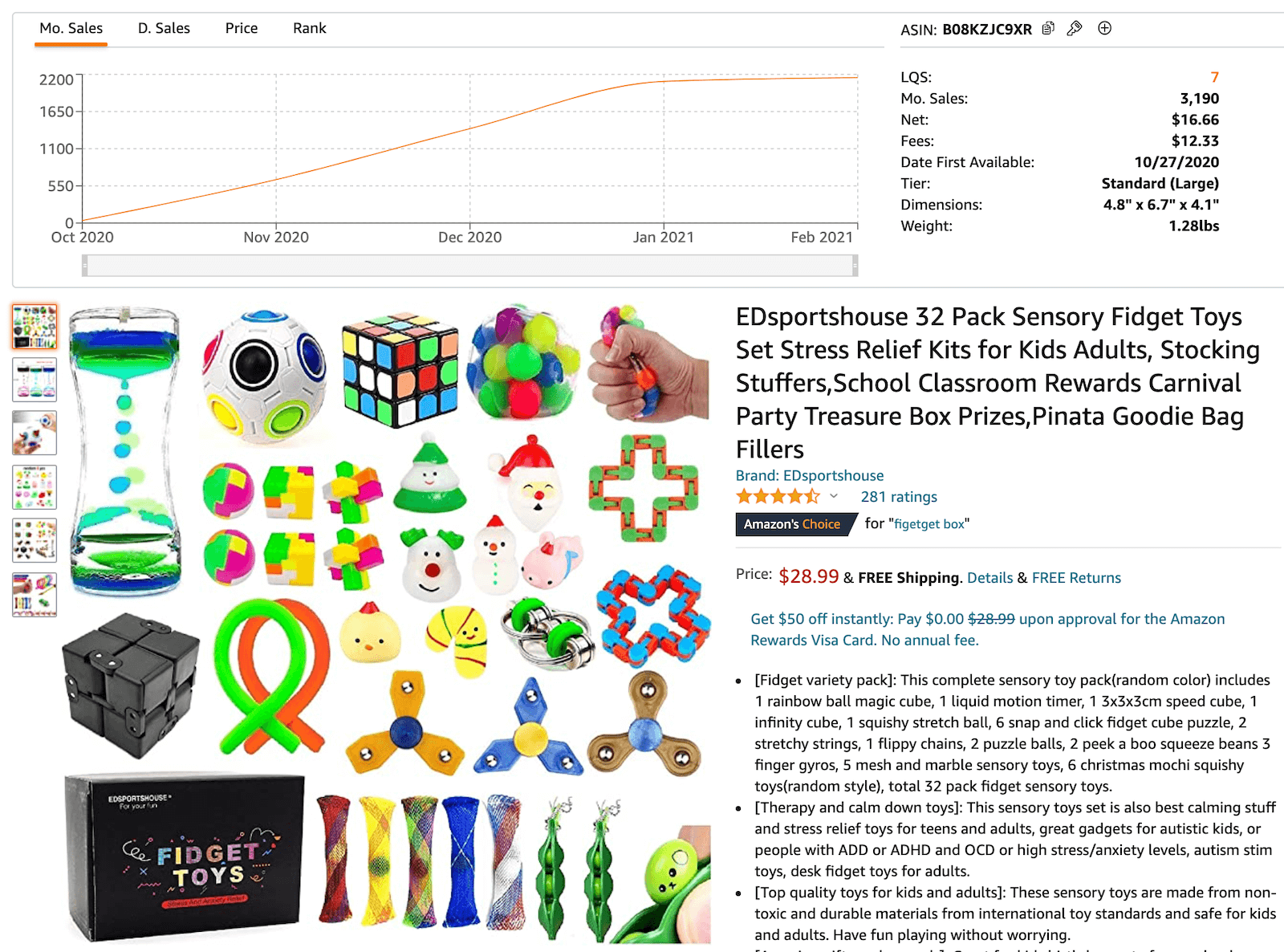
Selling office supplies
Pros: Newsflash: remote work is here to stay. That means home office supplies are likely to be a continuous source of revenue for brands that shine in this category.
Cons: If you want to sell office electronics, you’re up against tech titans like Apple, Dell, and Samsung. But that doesn’t mean you can’t succeed. Consider Anker, a brand that started out selling batteries and charging cables on Amazon and is now a publicly-traded company with around $1 billion in sales for 2020.
17. Cricut-compatible items
Cricut is a line of “smart” cutting machines that can chop paper, fabric, leather, and other materials into a variety of patterns and shapes. It’s now easier than ever to cut vinyl sheets into complicated floral motifs—and to make a profit on vinyl sheet bundles online.

18. Pottery products
Handmade pottery is super popular online—even big brands like Crate & Barrel and Target are trying to bank on the rustic-look trend. Plenty of people are trying their hand at DIY ceramics, and are looking to buy everything from clay to sculpting tools online.

Selling arts, crafts & sewing products
Pros: Consumers are leaning into their hobbies, which often include handicrafts like knitting, painting, and scrapbooking. Two in five consumers will buy products in this category online.
Cons: Thanks to Pinterest, crafting hobbies can get wildly popular very quickly, which can mean an overnight influx of competition in a formerly low-competition niche. Keep your brand ahead of the pack by accumulating plenty of great customer reviews.
19. Vinegar-based all-purpose cleaner
Top household cleaner brands are innovating by rebranding a cleaning ingredient that’s been around forever. Try creating your own line of gentle but effective cleaners.

20. Innovative spray bottles
Offer customers a spray bottle that provides an edge—say, super-fine mist, continuous spray, or fun shapes and colors—and you could make six-figure monthly sales.

Selling cleaning supplies
Pros: Unsurprisingly, this is the second-most popular product category among consumers in 2021, with 39% of consumers making online purchases. If you can’t or don’t want to sell the hard stuff (bleach, hydrogen peroxide, and other harsh cleaners), you can take advantage of the demand for “eco-friendly” solutions and recycled or biodegradable tools.
Cons: Cleaning supplies can be tricky to sell on certain ecommerce platforms like Amazon. Selling a product that could be considered a pesticide, or could contain pesticides, will get your listing suspended on the Everything Store. Amazon has also cracked down on sales of COVID-related products like disinfectants and masks.
How to Discover a Product Opportunity: Product Research
How did we arrive at these ecommerce business ideas? We did some research of our own into consumer behavior and seller trends to assess market demand and competition in popular product categories.
The products consumers want to buy change all the time. While some offer flash-in-the-pan success, others are worth building an ecommerce business around. A careful analysis of what people will buy online in 2021, factoring in how existing retailers are capitalizing on product trends to meet these needs, helped us reveal profitable ideas for new ecommerce sellers. The below insights are from our Consumer Trends Report, which we update on a quarterly basis, as well as our 2021 State of the Amazon Seller Report.
Consumer trends
In the new year, U.S. consumers are increasingly focused on their physical and mental health, their families (including pets), and their spirituality. Many have also had time away from their normal social lives to slow down and take stock of their situations, and are now thinking more seriously about their careers, education, finances, and civic engagement.
Since COVID began, people have made big changes to their everyday lives, including working and learning remotely, and finding ways to exercise and entertain themselves at home. Many of these changes are likely to remain even when social distancing ends.
These shifting values and needs mean new niche interests for ecommerce sellers. But how willing are U.S. shoppers to spend money on new products?
Between social distancing, financial uncertainty, and supply-chain disruptions, consumers have been through a lot in the past year. More than half of consumers are concerned about having enough money for retirement and emergencies, as well as suffering a loss or reduction of income. At least 43% say they are putting off major financial decisions for the time being.
But while many consumers tightened their belts in response to the changing economy, that hasn’t stopped them from shopping in general.
On the contrary, many U.S. consumers have simply shifted from in-store to online shopping. There’s evidence that this shift from brick-and-mortar to online shopping was accelerated by COVID-19; more consumers now report that they’re shopping at online retailers like Amazon than in months prior. Since October 2020, at least 74% of U.S. shoppers have searched for a product online, and many are now buying more products in certain categories (essential and health-related items like groceries, cleaning supplies, and vitamins, for instance) than before the COVID-19 pandemic.
Furthermore, the number of consumers who report increased overall spending jumped 20% from September to December 2020—ditto a noteworthy increase in online spending. This indicates further growth in consumer spending on the horizon, and a boon for ecommerce.
To summarize, consumers’ biggest focus areas in 2021 will be:
- Their families
- Physical health
- Mental health
- Personal finances
- Pets

Consumers are most likely to shop online in these product categories:
- Clothing
- Books
- Electronics
- Beauty & Personal Care
- Home & Kitchen
- Vitamins & Supplements
- Toys & Games
- Office Supplies
- Arts, Crafts, & Sewing
- Cleaning supplies
And in terms of what consumers are generally buying more of in 2021, here’s the breakdown:
- Grocery
- Cleaning supplies
- Vitamins
- Beauty & Personal Care
- Toys & Games
- Over-the-counter medicine
- Clothing
- Arts, Crafts, & Sewing
- Books
- Alcohol

The intersections of these values and in-demand product categories are the best places to look when starting an ecommerce business in 2021.
Niche competition and profitability
Consumer behavior can’t be your only consideration when finding a product to sell. You’ll also need to think about niche saturation—in other words, how many other people have already jumped on the idea with their own line of products.
This goes for the competitiveness of the ecommerce platforms themselves. Amazon currently has as many as 2.6 million third-party sellers. While they’re competing for sales from a bountiful 300-million-strong customer pool, that’s still a quite dense concentration of sellers. By comparison, eBay hosts around 800,000 stores, and Walmart’s online marketplace has an estimated 50,000 sellers. So while Amazon’s customer reach is larger than these other sites, it can be lucrative to take advantage of relatively lower competition elsewhere.
Jungle Scout’s Opportunity Finder tool allows ecommerce sellers to search specific keywords within a product category to find out what’s selling, or related products that are likely to sell. And while the sales data used to reveal opportunities is specific to Amazon, the insights are transferable to other ecommerce platforms. That’s because Amazon captures data on the majority of U.S. consumers’ shopping habits—it’s the most popular retailer in the country, even beyond traditional retail giants like Walmart and Target.
According to Jungle Scout’s 2021 State of the Amazon Seller Report, and perhaps unsurprisingly, Amazon sellers tend to concentrate in consumers’ preferred product categories, like Home & Kitchen, Toys & Games, and Beauty & Personal Care. While it’s important to note that more sellers in a given niche will mean a tougher road toward the top of Google or Amazon search results, there’s always a new, specific need to fulfill, whether it’s changing the look of a product to suit design trends or adding extra functionality.
By identifying products with high demand and relatively low competition on Amazon, you can strike gold—by creating a new product or modifying product ideas that need work to suit consumers’ needs.
Sometimes, pinpointing profitable improvements to an existing product niche is as easy as reading customer reviews. Thanks to customer-submitted photos and videos, you can literally see how a product is lacking, and how you could provide a superior alternative.
Launch your ecommerce business idea in 2021
If you’ve made it this far, you now have some great ecommerce business ideas, plus pointers on which tools will help you optimize your product. For more information on how to launch a product online, see Jungle Scout’s in-depth guides:
- How to Sell on Amazon
- How to Sell on Walmart
- How to Sell on eBay
- How to Sell on Facebook Marketplace
As you grow your brand, you’ll also want to check out our helpful guides on marketing, getting reviews, and fulfillment optimization:
- Amazon Advertising Guide
- How to Get Reviews on Amazon
- How to Sell on Shopify
- How to Integrate Amazon FBA with Shopify
Do you have a great idea for an ecommerce business? Tell us about it in the comments.

 4 Comments
4 Comments
4 comments on “Top 20 Ecommerce Business Ideas for 2021”